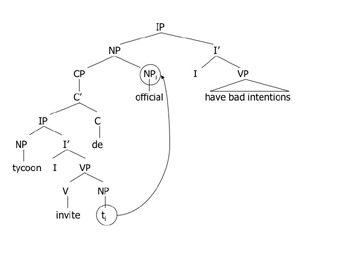9.59J / 24.905J Psycholinguistics, Fall 2002

The Chinese word order for the relative clause sentence, "The official who the tycoon invited has bad intentions." (Graphic courtesy of Prof. Edward Gibson.)
Highlights of this Course
The ability to communicate arbitrary ideas through thin air via sound waves is a complex and fascinating process. In this course we will study how language is represented, processed and acquired, with a concentration on how language is comprehended in real time. The site features a comprehensive
reading list and
assignments tailored for the undergraduates who enroll in this class.
» View this course
en Español courtesy of
Universia.
Course Description
Central topics in language processing. The structure of language. Sentence processing. Discourse processing. Morphological processing. The storage and access of words in the mental dictionary. Speech processing. The relationship between the computational resources available in working memory and the language processing mechanism. Ambiguity resolution. Discussion of computational modeling, including connectionist models. The relationship between language and thought. Issues in language acquisition including critical period phenomena, the acquisition of speech, and the acquisition of words. Experimental methodologies such as self-paced reading, eye-tracking, cross-modal priming, and neural imaging methods.